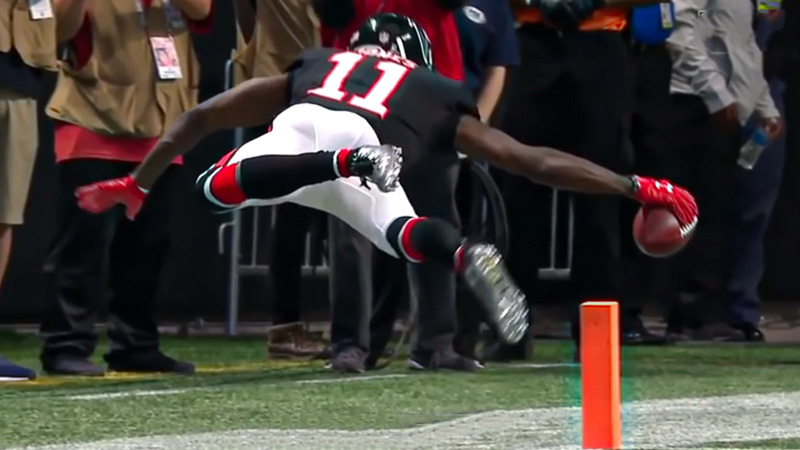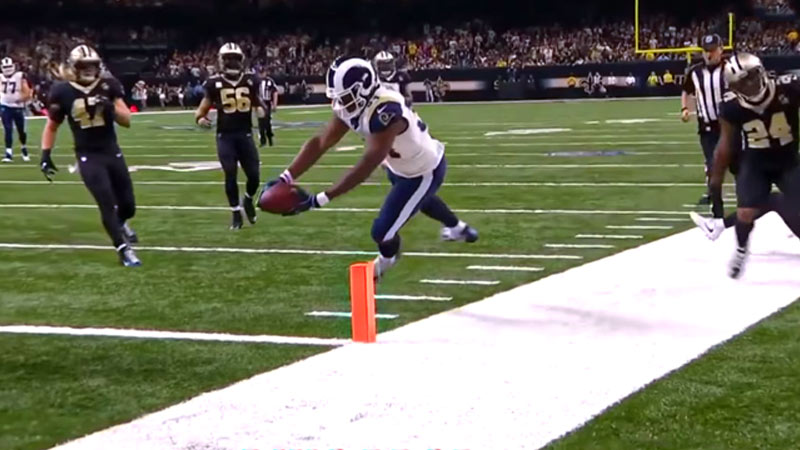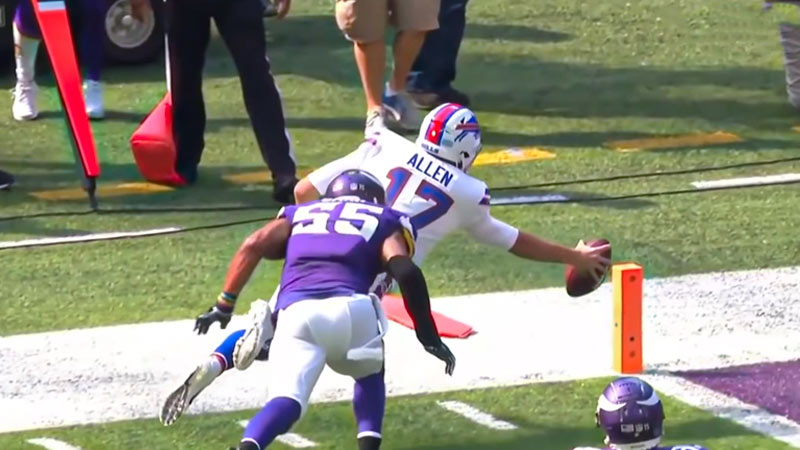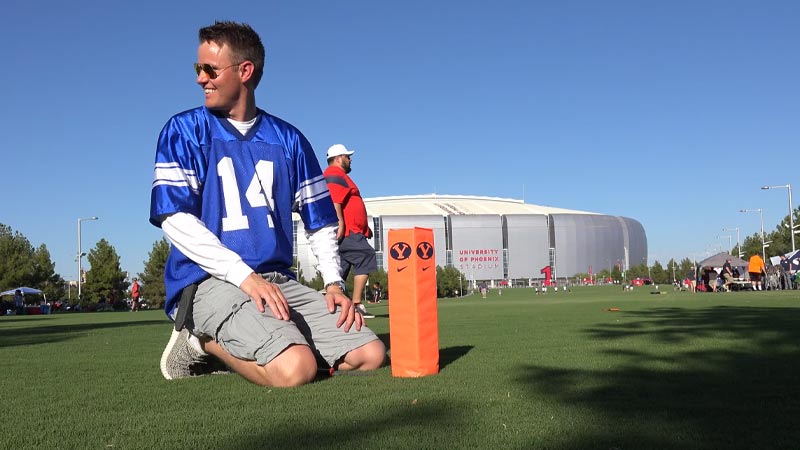In the captivating world of American football, every element on the field serves a purpose, contributing to the excitement and strategy that fans and players alike cherish.
Among these elements, football pylons stand as silent sentinels, marking the boundaries of the end zone and the goal line. But what exactly are football pylons used for?
This blog post delves into the essential role these vibrant markers play in the game, answering some of the most frequently asked questions surrounding their purpose and significance.
What are Football Pylons?
Football pylons, also known simply as “pylons,” are markers used in American football to indicate the boundaries of the end zone and the goal line.
They are typically bright orange or fluorescent in color and are placed at each corner of the end zone and at the intersection of the goal line and the sidelines.
The pylons serve as visual aids for players, officials, and spectators to determine whether a player carrying the ball has crossed the goal line and entered the end zone for a touchdown.
When a player with the ball touches or crosses the pylon, it is considered a touchdown as long as the player maintains possession of the ball and other relevant rules are met.
Pylons are also used during certain sideline plays, such as when a ball carrier steps out of bounds. If a player carrying the ball steps out of bounds and touches the pylon, it is considered the same as stepping out of bounds on the field of play.
What is Football Pylons Used for?

Football pylons are primarily used for marking and determining the boundaries of the end zone and the goal line in American football. Their main purposes include:
Scoring Touchdowns
Pylons are crucial for determining whether a player carrying the ball has successfully crossed the goal line and entered the end zone, scoring a touchdown for their team.
When a player with the ball touches or crosses the pylon while maintaining possession, it counts as a touchdown.
Out of Bounds
Pylons also serve as markers for determining whether a player carrying the ball has gone out of bounds. If a player steps out of bounds and touches the pylon, it is considered the same as stepping out of bounds on the field.
Visual Reference
Pylons provide a clear visual reference for players, officials, and spectators to understand the position of the goal line and the end zone. This helps avoid confusion and ensures accurate judgments during critical moments of the game.
Officiating Assistance
Referees and officials use pylons to help make accurate calls on whether a touchdown has been scored or if a player has gone out of bounds. The pylons provide a clear reference point for these decisions.
Ceremonial and Decorative Use
Pylons are sometimes used for ceremonial and decorative purposes during special events, such as championship games or commemorative matches. They contribute to the overall aesthetics and ambiance of the game.
Television Broadcasts
Pylons also play a role in television broadcasts, providing viewers with a clear visual marker to understand scoring and boundary-related situations.
Football pylons play a critical role in the game of American football by helping determine scoring plays, ensuring fair and accurate officiating, and enhancing the overall spectator experience.
Benefits of Using Football Pylons

The use of football pylons provides several benefits to the game of American football, players, officials, and spectators. Some of these benefits include:
Clear Scoring Determination
Pylons help provide a definitive visual marker for determining whether a player carrying the ball has crossed the goal line and entered the end zone. This assists officials in making accurate touchdown calls, reducing ambiguity and controversy.
Accurate Out-of-Bounds Calls
Pylons serve as clear indicators for determining whether a player has gone out of bounds. When a player touches the pylon while going out of bounds, it assists officials in making precise out-of-bounds calls.
Enhanced Officiating
Referees and officials can use pylons as reference points during crucial moments of the game, such as reviewing scoring plays and boundary-related situations. This helps ensure fair and accurate officiating.
Player Awareness
Pylons help players gauge their position on the field, especially when approaching the goal line. This can influence their decision-making during plays and contribute to strategic gameplay.
Spectator Understanding
Pylons provide a clear visual cue for spectators, helping them better comprehend scoring and boundary-related situations. This enhances the overall fan experience and engagement.
Television Broadcast Clarity
Pylons improve the clarity of televised broadcasts by offering viewers a distinct reference point for scoring and boundary judgments. This contributes to a more enjoyable viewing experience.
Iconic Symbolism
Pylons have become iconic symbols of American football, representing the excitement of scoring touchdowns and the sport’s unique characteristics. They contribute to the visual identity and cultural significance of the game.
Consistency and Standardization
The use of pylons helps maintain consistency and standardization in the game, ensuring that the same rules and visual cues apply across different stadiums and competitions.
Reduced Disputes
By providing clear visual evidence of scoring and boundary-related situations, pylons can help reduce disputes and arguments among players, coaches, and fans.
Game Aesthetics
Pylons, often brightly colored and positioned prominently on the field, contribute to the aesthetic appeal of the game. They add vibrancy to the field and enhance the overall visual experience.
Football pylons offer a range of benefits that contribute to the accuracy of officiating, the understanding of players and spectators, and the overall enjoyment of American football as a sport.
Essential Facts to Know About Football Pylons

Here are some essential facts about football pylons:
Purpose and Placement
Football pylons are used to mark the boundaries of the end zone and the goal line. They are typically placed at each corner of the end zone and at the intersection of the goal line and the sidelines.
Color and Visibility
Pylons are usually bright orange or fluorescent in color to enhance visibility for players, officials, and spectators. Their vibrant color makes them easily distinguishable on the field.
Material and Design
Pylons are typically made of soft foam or rubber materials to ensure player safety in case of collision. They are designed to be lightweight and easily repositioned if necessary.
Touchdown Determination
When a player carrying the ball touches or crosses the pylon while in possession of the ball, it is considered a touchdown, as long as other relevant rules are satisfied.
Out-of-Bounds Marker
Pylons are used as indicators for determining whether a player has gone out of bounds. If a player steps out of bounds and touches the pylon, it is treated the same as stepping out of bounds on the field.
Referee and Instant Replay Use
Referees and officials use pylons as reference points during instant replay reviews to make accurate decisions regarding scoring plays and boundary-related situations.
Symbolic Significance
Pylons have become symbolic elements of American football, representing the excitement of scoring and the unique characteristics of the sport.
Ceremonial Use
Pylons are sometimes used for ceremonial purposes during special events, such as championship games or commemorative matches, adding to the spectacle of the game.
Television Broadcast
Pylons aid television broadcasters in providing viewers with clear visual cues for scoring and boundary-related judgments.
Consistency Across Fields
The use of pylons helps maintain consistency in the rules and visual markers across different football fields and competitions.
Safety and Player Awareness
Pylons not only mark boundaries but also serve as points of reference for players, helping them maintain spatial awareness and avoid collisions.
Evolution
While the basic concept of pylons has remained consistent over time, their design and materials have evolved to ensure player safety and overall game experience.
Pylon Cam
In some cases, cameras have been mounted on or near pylons to capture unique angles and perspectives during televised broadcasts.
Cultural Icon
Pylons have become synonymous with the excitement and drama of football, making them an integral part of the sport’s cultural and visual identity.
Football pylons play a significant role in the mechanics, safety, and visual aesthetics of American football, contributing to the game’s overall appeal and enjoyment.
How to Use Football Pylons?
Football pylons are used in several ways during an American football game to mark boundaries, determine scoring plays, and assist officials. Here’s how football pylons are used:
Step 1: Marking the End Zone and Goal Line
Pylons are placed at each corner of the end zone to mark its boundaries. They are also positioned at the intersection of the goal line and the sidelines.
Step 2: Scoring Touchdowns
The pylons play a crucial role in determining whether a touchdown has been scored. When a player carrying the ball crosses the goal line and touches or crosses the pylon with possession of the ball, it is considered a touchdown. The pylon serves as a visual marker to help officials make accurate scoring decisions.
Step 3: Out-of-Bounds Calls
Pylons are used to assist officials in making out-of-bounds calls. If a player steps out of bounds and touches the pylon, it is treated the same as if the player stepped out of bounds on the field.
Step 4: Instant Replay Reviews
Pylons are often used as reference points during instant replay reviews. Officials can examine footage to determine whether a player’s interaction with the pylon corresponds to a touchdown or an out-of-bounds situation.
Step 5: Player Awareness
Players use pylons as visual cues to gauge their position on the field, especially when approaching the goal line. The pylon helps them make split-second decisions during plays.
Step 6: Referee Guidance
Referees and officials refer to pylons to make accurate calls during the game. They use the pylons to determine whether a player has scored or gone out of bounds.
Step 7: Television Broadcasts
Pylons enhance the visual experience for television viewers, providing clear indicators for scoring plays and boundary situations. Broadcasters often use pylons as reference points in replays.
Step 8: Ceremonial and Decorative Use
Pylons can be used ceremonially, such as during special events or pre-game festivities, adding to the spectacle of the game.
To use football pylons effectively, players, officials, and spectators need to be familiar with their significance and role in the game. Pylons contribute to the accuracy of officiating, the determination of touchdowns, and the overall understanding of boundary-related situations during American football matches.
FAQs
What is the primary purpose of football pylons?
Football pylons are primarily used to mark the boundaries of the end zone and the goal line on the football field. They serve as crucial indicators for players, officials, and spectators, aiding in determining scoring plays and out-of-bounds situations.
How do football pylons help determine touchdowns?
When a player carrying the ball crosses the goal line and touches or crosses a pylon with possession of the ball, it is considered a touchdown. The pylon acts as a visual marker, assisting officials in making accurate scoring decisions.
Are the pylons only used for scoring touchdowns?
No, pylons serve multiple purposes. They also assist officials in making out-of-bounds calls. If a player steps out of bounds and touches a pylon, it is treated the same as stepping out of bounds on the field.
Do football pylons have any significance beyond the game?
Yes, football pylons have become iconic symbols of the sport, representing the excitement and drama of scoring touchdowns. They are often used ceremonially during special events and contribute to the overall visual identity of American football.
How do television broadcasts utilize football pylons?
Television broadcasts leverage pylons as clear visual cues for viewers, enhancing the understanding of scoring plays and boundary-related situations. Pylons are often referenced in replays to provide a better perspective on key moments.
Wrapping Up
In the grand tapestry of American football, each component plays a vital role, and football pylons are no exception. As we’ve explored in this blog post, these bright markers do far more than simply decorate the field.
They serve as beacons of clarity, guiding players, officials, and fans in understanding touchdowns, out-of-bounds scenarios, and the very essence of the game.
With their significance extending beyond the field, football pylons have etched their place not only as functional tools but also as enduring symbols of the sport’s dynamic nature and cultural impact. Best wishes.







